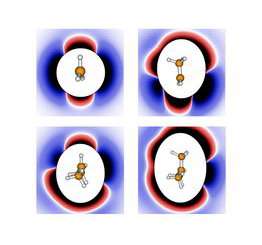Researchers couple chemistry, large-scale computing for combustion calculations in a flash

Chemists at the U.S. Department of Energy's Argonne National Laboratory have brought together advances in theoretical chemical kinetics and high-performance computing to speed research in the chemistry of fuel combustion that may lead to cleaner more efficient combustion devices. The scientists developed a new approach to predict the rates of chemical reactions that greatly increases efficiency while maintaining accuracy, cutting costs and allowing research on larger molecules.
"We can now calculate the rates for reactions of interest to us within days to a week, compared to six months to a year previously," said journal author Stephen Klippenstein. The report, "Predictive Theory for the Combination Kinetics of Two Alkyl Radicals" is published in the March 14 issue of Physical Chemistry Chemical Physics.
These chemists are performing basic research on radical-radical reactions relevant to the combustion of hydrocarbons. "Our research goal," said senior chemist Larry Harding, "is to develop accurate models of combustion chemistry that might one day be used to design more efficient or cleaner-burning combustion devices." These methods can also be used to advance research in atmospheric and interstellar chemistry.
Accurate experimental measurements of these reaction rates are challenging because the radicals are difficult to produce in the laboratory. Consequently, only a small number of radical-radical reaction rates have been measured accurately. Previous theoretical methods required long computer simulations and could only be applied to small radicals.
"The new technique couples efficient quantum chemistry and reaction rate theory with large-scale parallel computing," said Harding. The team of three chemists – including postdoctoral researcher Yuri Georgievskii – adapted a fast but less accurate method for calculating the needed radical-radical interaction potentials with a simple correction to obtain accurate results.
Harding explains, "the new method has been successfully applied to both self- and cross-combinations of methyl, ethyl, iso-propyl and tert-butyl radicals, answering a long-standing debate about temperature dependence of these reactions. The reaction rates decrease with increasing temperature."
This finding is the opposite of expected behavior because most reactions speed up as the temperature increases. This new information is critical because in the past, combustion models have often used extrapolations of room temperature measurements. "Now we can validate our methods with comparisons to room temperature measurements, then correctly extrapolate to the higher temperatures needed for combustion modeling," said Klippenstein.
The new approach also:
-- Validated the geometric mean rule first postulated in the 1960s. "This appears to be a reliable way to relate the rates of cross reactions to the rates of the corresponding self reactions," said Klippenstein.
-- Demonstrated that the effect of methyl substituents adjacent to the radical site follows a simple rule – each additional substituent slows the reaction by a factor of two. For example, the reaction of methyl (CH3) with ethyl (C2H5) is twice as fast as the reaction of methyl with iso -propyl (i-C3H7), which has one more methyl group.
The researchers are moving on to new territory. The chemists have so far only looked at hydrocarbon radicals and now want to investigate oxygenated radicals because combustion occurs in the presence of oxygen.
Another topic to be addressed in the near future is resonance-stabilized radicals. "These radicals tend to be more stable than the other radicals and, as a result, are present at higher concentrations in flames," said Harding. Resonance-stabilized radicals also have multiple reactive sites, while those they have studied up to now have only a single reactive site.
The work is supported by the Division of Chemical Sciences, Geosciences and Biosciences in DOE's Office of Basic Energy Sciences. Research was also performed at Sandia National Laboratory, operated by Sandia Corp., a Lockheed Martin Co.
Source: Argonne National Laboratory















